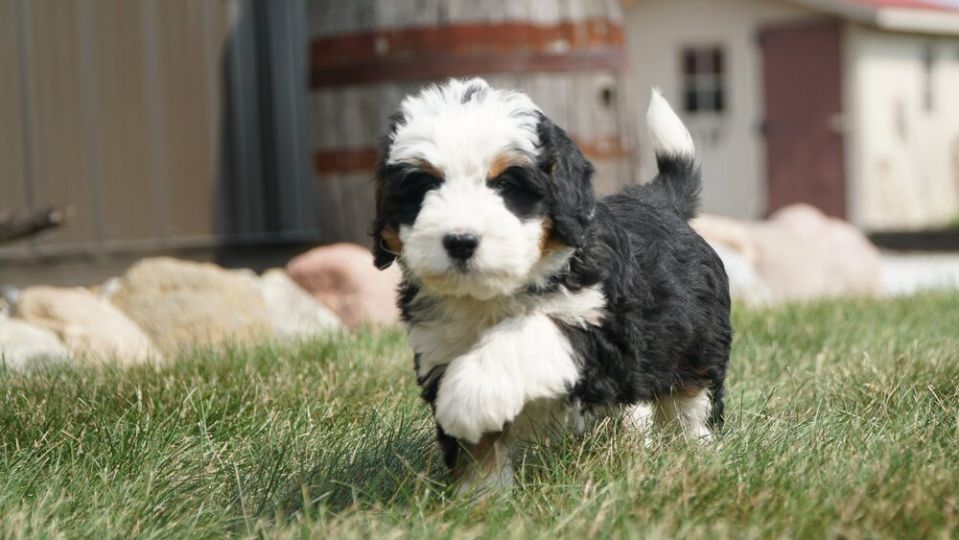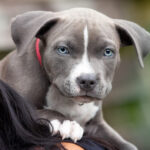In search of a new, lifelong best friend? Not sure which breed of puppy will suit you and your family the best? From the perspective of a puppy trainer, we’re giving you a deeper look into Bernedoodle puppies.
Bernedoodles are the ultimate in having the best of both worlds! Over the past 20 years, these mixed-breed designer puppies have quickly risen to the top of the list of preferred puppy breeds because they were bred to be the ideal companion dogs!
How can you tell if a Bernedoodle would be a good fit for your family? You can get a puppy trainer’s perspective on this breed from us, including information on their personalities, care requirements, and of course, training suggestions to help you raise a wonderful adult dog!
Appearance
Poodles are able to have a much wider variety of coat colors than Bernese mountain dogs, who are typically black, tan, and white. As a result, Bernedoodles can have a wide range of colors. Although they usually have a tricolor coat like their mountain dog parents, they can also be all-black, all-white, or a random mixture.
Additionally, they can have fur that is straighter like a Bernese mountain dog, or curlier like a poodle. Generally speaking, your Bernedoodle will shed more the straighter its coat is. Both situations allow the Bernedoodle to thrive in colder climates due to its thick mane.

Because it is thought to be hypoallergenic, a curly Bernedoodle coat is frequently desired. The coat of this breed may be a good choice for people who frequently sneeze, sniffle, or itch around dogs, even though no dog is completely allergen-friendly.
Poodles can be found in three sizes: toy, miniature, and standard, so Bernedoodles can as well. Breeders of Bernedoodles frequently offer three different sizes—tiny, miniature, and standard—to accommodate the various care and living requirements of each puppy.
If she gets plenty of walks and exercise, a smaller mix could easily live in an apartment. The typical Bernedoodle can weigh up to 90 pounds and stand up to 29 inches tall.
Minis are 20–45 pounds in weight and range in height from 18–22 inches. A “tiny,” bred from a toy poodle, is only 12–17 inches and weighs 10–24 pounds, according to the Federal Bernedoodle Registry.
Size
Every home, from a small apartment in the city to a large family home in the country, can accommodate a Bernedoodle. Typically, the size of a Bernedoodle depends on the generation and size of its poodle parents.
Due to their genes containing 50% poodle and 50% Bernese mountain dog, first-generation cross Bernedoodles are typically larger. When a higher proportion of poodles is included in the mix, second-generation F2 and multigenerational Bernedoodles may be smaller.
Coat
The coats of Bernedoodles can be straight, wavy, or curly in addition to the various sizes and shapes that they come in. The latter is more common, whether someone has a family with mild allergies or just wants to reduce the amount of fur that gets on their furniture.
Curly-haired Doodles have more demanding grooming requirements but shed less than their wavy- or straight-haired counterparts.
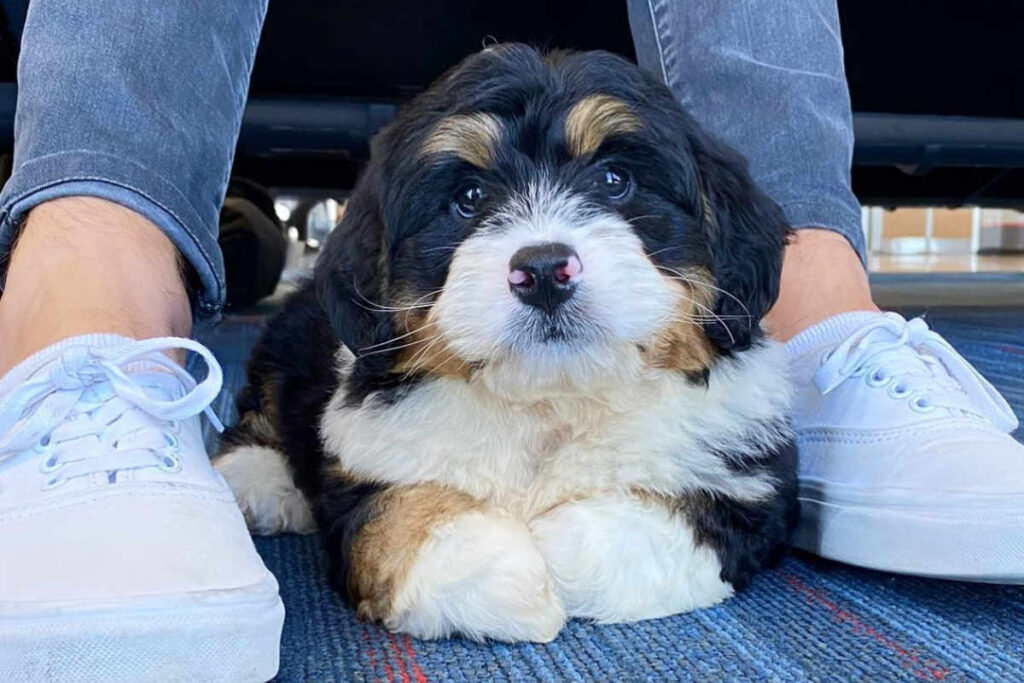
Although they are the most grooming-friendly, straight coats shed more than wavy or curly coats. This type of doodle is the rarest because of its generally normal shedding. A middle ground is reached by wavy-coated Bernedoodles.
Colors
Any combination of black, brown, and white can be seen on Bernedoodle coats. Black and white, black and brown, and all shades of black are common. Sable is another choice, but it is also the most expensive because it is the hardest to intentionally breed.
The merle Bernedoodle, an even rarer gem, has emerged in recent years. These dogs have marbling that includes white, brown, and occasionally gray.
Training
Young Bernadoodles often take after their poodle and Bernese mountain dog parents’ stubbornness. It’s important to start training as early as possible because this is often the case with small and toy dogs.
Doodles’ calm, eager-to-please, and intelligent personalities make them highly responsive to training, provided they receive the right input. They will still be cheeky, naughty, and independent, but just keep in mind that patience, consistency, and positive reinforcement will always yield the best results.
Being impatient or angry with a Bernedoodle can be completely counterproductive because they are highly sensitive dogs. Treats, interactive play, and effusive verbal praise when your dog performs well will always be far more effective than yelling at them or correcting them when they make a mistake.
During the puppy stage, it’s crucial to thoroughly socialize them by exposing them to sights, sounds, people, places, and animals in a safe, controlled manner. By doing this, you stop them from becoming overly nervous or excited when faced with novel situations.
Exercise
Bernedoodles are typically regarded as having moderate levels of activity, though this can vary depending on a number of factors. They enjoy being outside and enjoy swimming, running, and walking, but they don’t need to engage in frequent, vigorous activity.
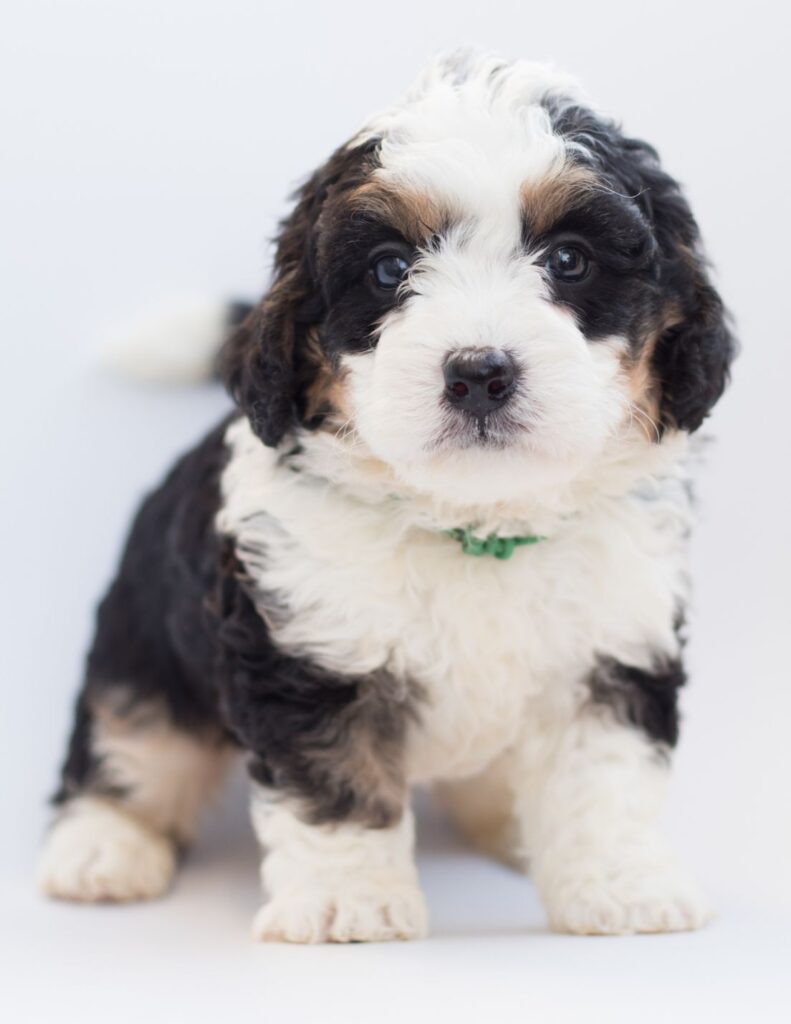
Toy or miniature doodles can make wonderful apartment pets, but even these tiny canines require a lot of space to move around and at least one daily long walk.
Despite the fact that their parent dogs may have been working dogs, the traits of this breed have been chosen to ensure that they make devoted, affectionate companions. They are very adaptable and can change to fit your lifestyle if you give them enough opportunity to vent during the day.
Given their intelligence, mental as well as physical stimulation is essential. As a result, it’s a great idea to buy them a ton of interactive and puzzle toys to keep them from getting bored.
Living Environment
Your Bernedoodle puppy, no matter what size, will need to get enough exercise, which is why they thrive in households with active kids!
The activity level of tiny and mini Bernedoodles will be a little lower, and they can adapt to the smaller living quarters that come with urban settings, like apartments or condos.
In smaller homes, medium to standard-sized Bernedoodles may bump into more coffee tables and have trouble fitting in the same hallway with you because they are taller, wider, and can weigh up to 90 pounds.
This breed does best with access to a fenced-in yard or a nearby park that you can take them to!
Care
Within the first week of bringing your new Bernedoodle puppy home, make an appointment for their first visit to the vet!
You can ask any questions you may have about the health of your Bernedoodle during this visit, and you and your puppy’s veterinarian can discuss your puppy’s nutritional needs, growth development, and vaccination and spay/neuter schedules.
The Bernedoodle may have joint dysplasia, like many large-breed working dogs. Blood conditions, some cancers, and progressive retinal atrophy have all been reported in Bernese Mountain Dogs. In general, Bernedoodles are strong and healthy, especially if they are from a reputable breeder.
Brushing your puppy’s teeth will help prevent tooth decay, gum disease, and bad breath as part of general care for your Bernedoodle. In order to prevent ear infections, check and clean your pet’s ears frequently because floppy ears may make them more prone to getting them.
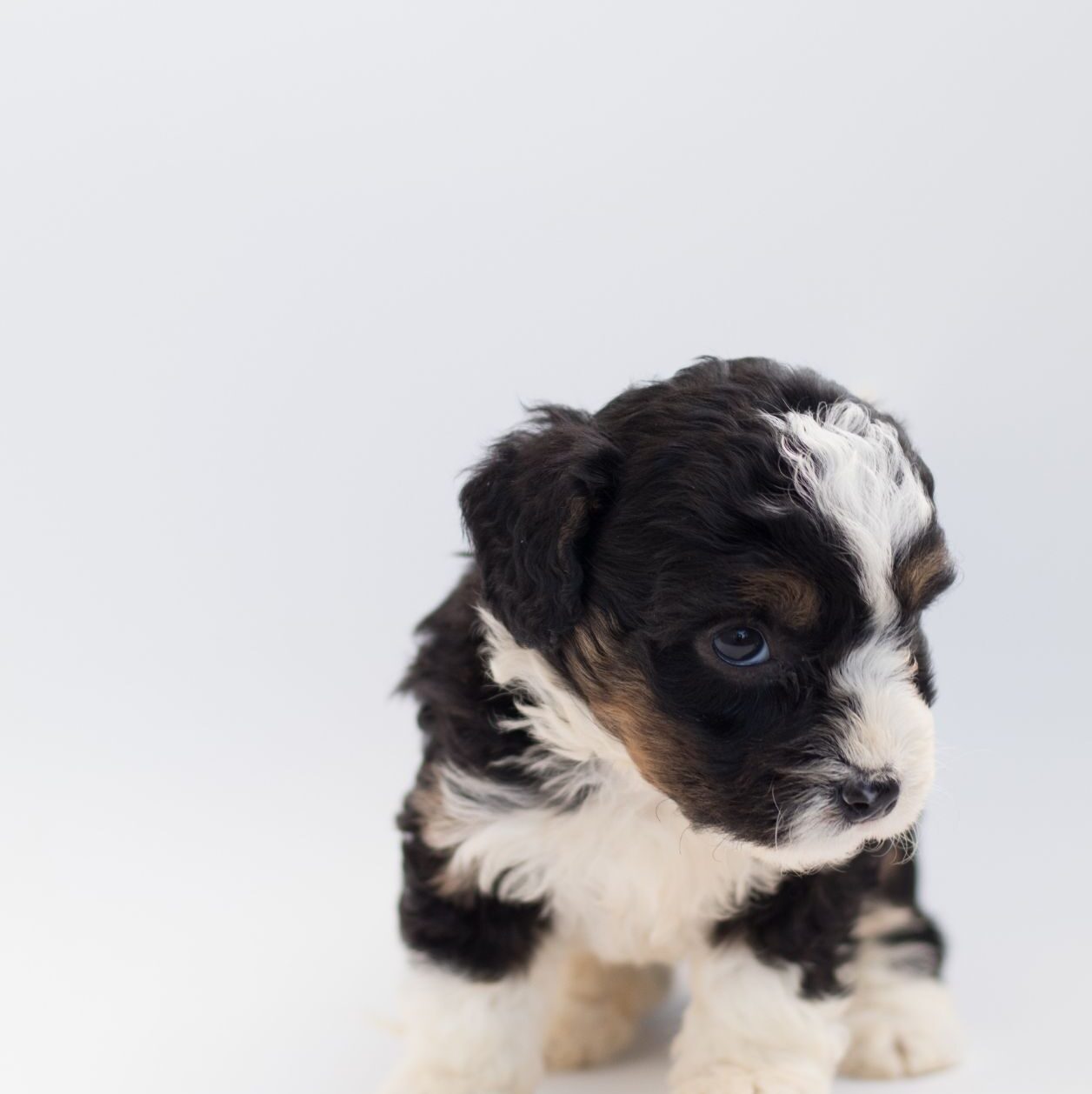
Depending on your puppy’s coat type, you might need to brush them frequently to prevent matting if they have a curly coat. Every few months, you should take your puppy to a professional groomer to have its fur cut.
Health
The lifespan of a Bernedoodle is 12–18 years. It’s a good thing that the hybrid breed does not carry the same health risks as the Bernese mountain dog. They have a life expectancy of only seven years and a high incidence of cancer, hip and elbow dysplasia, heart disease, and epilepsy on their Bernese side of the family.
And while Bernedoodles are far healthier than a purebred Bernese, they can still be “predisposed to hip dysplasia, elbow dysplasia, ocular diseases, and some allergies,” Christman says.
“The Bernedoodle is a generally wholesome breed that is wonderful for families. Just be aware of [warning signs like] excessive drooling and the potential to gain weight quickly.”
Because of their thick coats, skin conditions like hot spots can also be frequent in this group. Hot spots are typically brought on by excessive licking or chewing of a particular area. Since a Bernedoodle is more likely to pick at its skin when her coat is dirty and matted, maintaining proper grooming is crucial.
Nutrition
It is impossible to overstate the value of a healthy, balanced diet. Your dog will live longer and cost you less money in medical expenses if you are more aware of its specific nutritional needs.
Dogs enjoy eating, and there is always the temptation to indulge them by overfeeding them, but this is a surefire way to cause health problems in the future. Feed your pet the highest-quality food you can afford, and be sure to follow a regular feeding schedule.
Food can be divided into four categories: wet, kibble, cooked, and raw. Despite the rise in popularity of raw and cooked dog food, you should always speak with your veterinarian to make sure you’re feeding your pet a balanced diet.

The most wholesome and useful option is frequently a mix of dry and wet. Kibble and wet food can both cause digestive problems when consumed alone. Make sure to feed standard Bernedoodle food to larger dogs and miniature and toy Bernedoodle food to smaller dogs.
Grooming Requirements
Take your dog’s scent cues when choosing when to bathe him, but Bernedoodles typically require a bath every four to eight weeks. Avoid over-bathing as this can disrupt the balance of oils that keeps a doodle’s skin and coat comfortable and moisturized.
Give your dog’s ears and eyes a once-weekly cleaning, and trim its nails after every bath.
A trip to the groomer every three to five months keeps your Bernedoodle looking and feeling its best, and brushing it two to three times a week prevents mats and tangles. Nearly as much as we do, dogs enjoy being pampered!
If you want to use detangling spray on your doodle, make sure to pick a product made for that breed.
Till your Bernedoodle is between seven and nine months old, postpone trimming its coat. Its fur might stop growing normally for the rest of its life if it is done any earlier. Establishing a dental hygiene routine can help your pet live longer by preventing decay and cavities.
You Might Also Like:

